Human Resource Management in Health and Social Care Report
VerifiedAdded on 2019/12/04
|11
|3245
|131
Report
AI Summary
This report delves into the intricacies of Human Resource Management within the health and social care sector, using Care UK as a case study. It meticulously examines critical aspects such as recruitment strategies, considering both internal and external factors, and outlines the essential requirements for roles like hospital administrators. The report further explores legislative and policy frameworks influencing HR practices, including the Equal Pay Act and Data Protection Act. The selection process, encompassing preliminary interviews, written tests, and employment interviews, is analyzed. The importance of teamwork, exemplified by Belbin's and Tuckman's theories, and different team types like collaborative working and multi-disciplinary teams are discussed. Performance management systems, along with strategies for continuous development, such as mentoring and coaching, are evaluated. The report contrasts the roles of managers and leaders, differentiating between transactional and transformational leadership styles and highlighting the significance of emotional intelligence in the healthcare setting. Finally, reflections on team work activities and leadership and management are included, drawing on observations from a job shadowing experience.

Managing HR in Health &
Social Care
Social Care
Paraphrase This Document
Need a fresh take? Get an instant paraphrase of this document with our AI Paraphraser
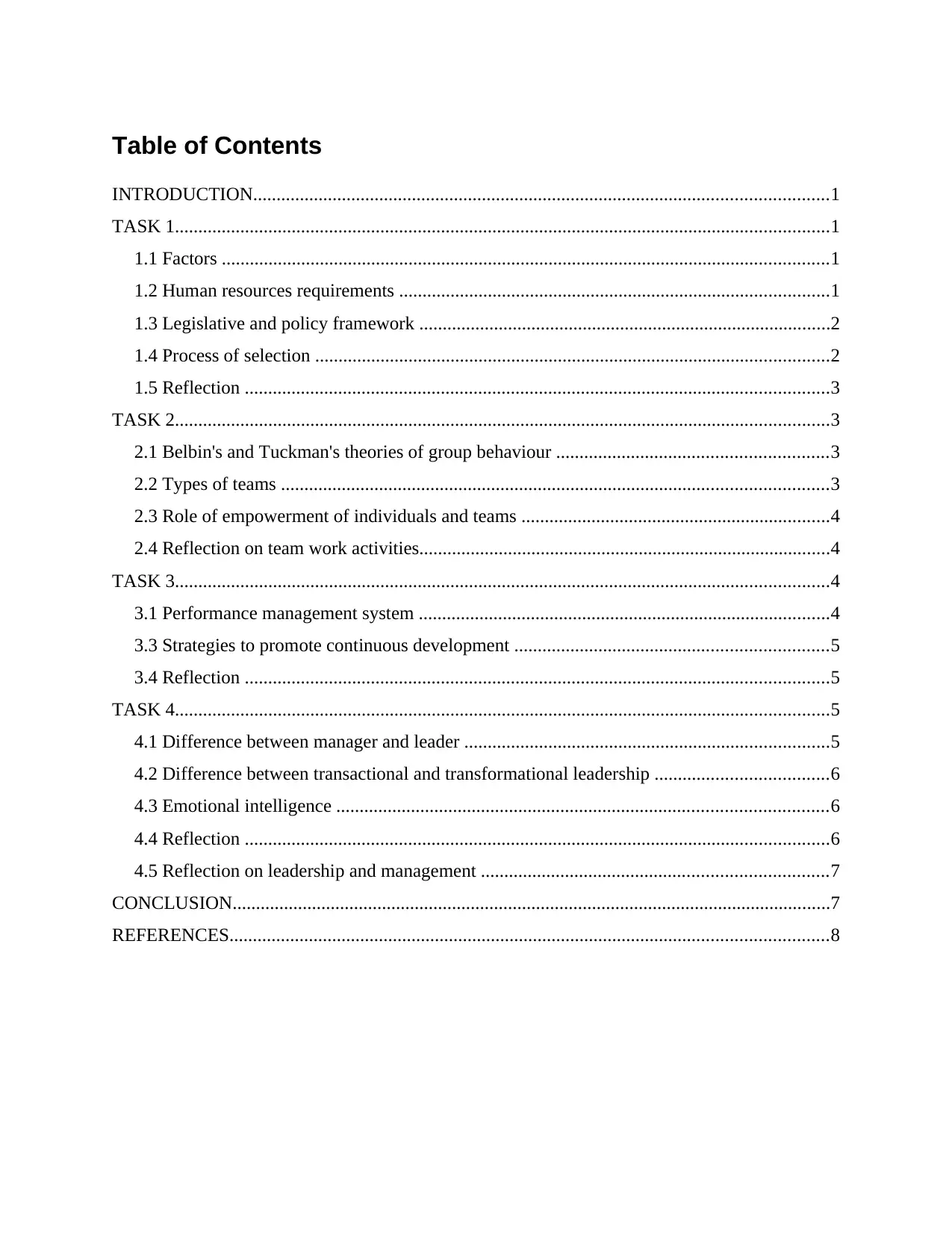
Table of Contents
INTRODUCTION...........................................................................................................................1
TASK 1............................................................................................................................................1
1.1 Factors ..................................................................................................................................1
1.2 Human resources requirements ............................................................................................1
1.3 Legislative and policy framework ........................................................................................2
1.4 Process of selection ..............................................................................................................2
1.5 Reflection .............................................................................................................................3
TASK 2............................................................................................................................................3
2.1 Belbin's and Tuckman's theories of group behaviour ..........................................................3
2.2 Types of teams .....................................................................................................................3
2.3 Role of empowerment of individuals and teams ..................................................................4
2.4 Reflection on team work activities........................................................................................4
TASK 3............................................................................................................................................4
3.1 Performance management system ........................................................................................4
3.3 Strategies to promote continuous development ...................................................................5
3.4 Reflection .............................................................................................................................5
TASK 4............................................................................................................................................5
4.1 Difference between manager and leader ..............................................................................5
4.2 Difference between transactional and transformational leadership .....................................6
4.3 Emotional intelligence .........................................................................................................6
4.4 Reflection .............................................................................................................................6
4.5 Reflection on leadership and management ..........................................................................7
CONCLUSION................................................................................................................................7
REFERENCES................................................................................................................................8
INTRODUCTION...........................................................................................................................1
TASK 1............................................................................................................................................1
1.1 Factors ..................................................................................................................................1
1.2 Human resources requirements ............................................................................................1
1.3 Legislative and policy framework ........................................................................................2
1.4 Process of selection ..............................................................................................................2
1.5 Reflection .............................................................................................................................3
TASK 2............................................................................................................................................3
2.1 Belbin's and Tuckman's theories of group behaviour ..........................................................3
2.2 Types of teams .....................................................................................................................3
2.3 Role of empowerment of individuals and teams ..................................................................4
2.4 Reflection on team work activities........................................................................................4
TASK 3............................................................................................................................................4
3.1 Performance management system ........................................................................................4
3.3 Strategies to promote continuous development ...................................................................5
3.4 Reflection .............................................................................................................................5
TASK 4............................................................................................................................................5
4.1 Difference between manager and leader ..............................................................................5
4.2 Difference between transactional and transformational leadership .....................................6
4.3 Emotional intelligence .........................................................................................................6
4.4 Reflection .............................................................................................................................6
4.5 Reflection on leadership and management ..........................................................................7
CONCLUSION................................................................................................................................7
REFERENCES................................................................................................................................8
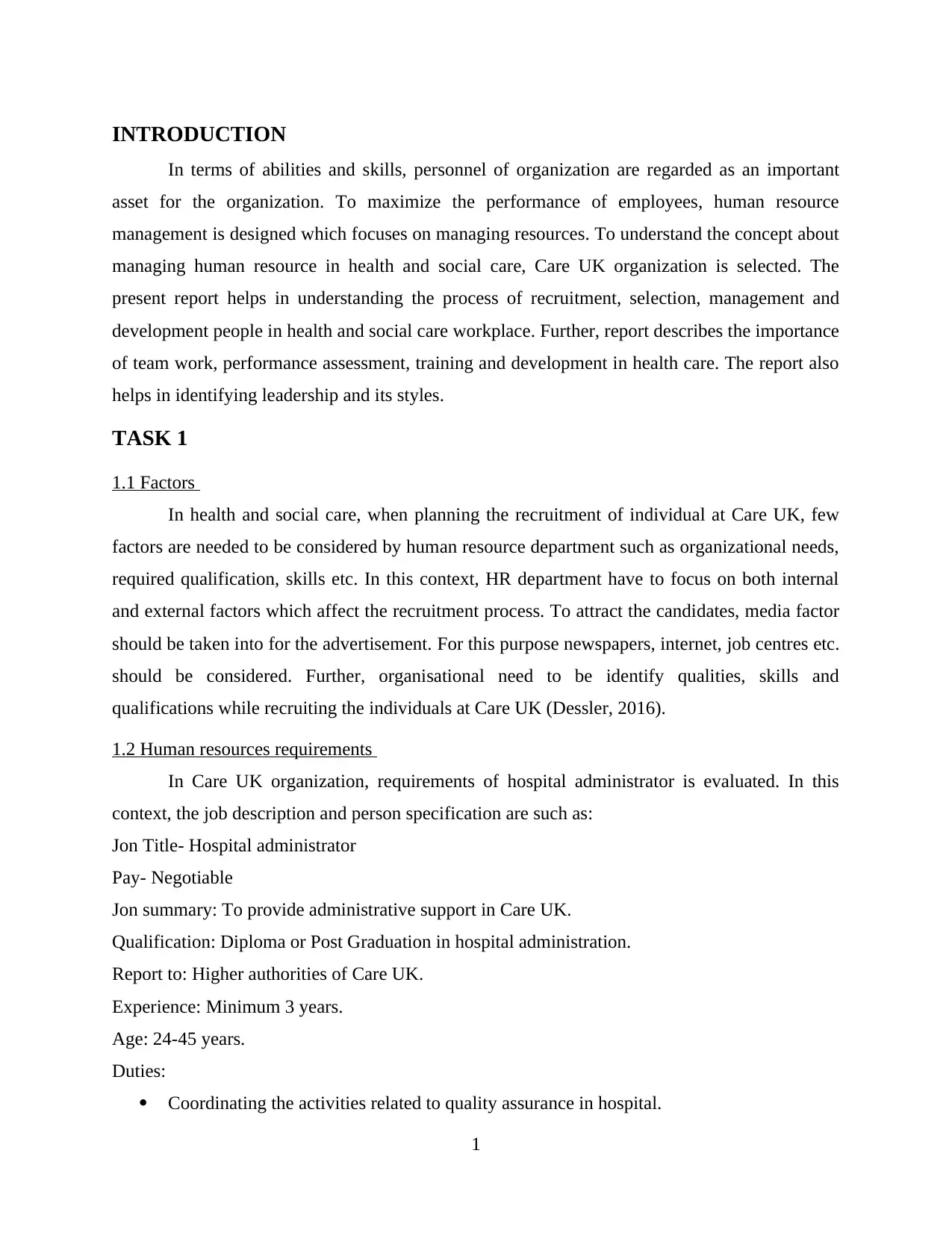
INTRODUCTION
In terms of abilities and skills, personnel of organization are regarded as an important
asset for the organization. To maximize the performance of employees, human resource
management is designed which focuses on managing resources. To understand the concept about
managing human resource in health and social care, Care UK organization is selected. The
present report helps in understanding the process of recruitment, selection, management and
development people in health and social care workplace. Further, report describes the importance
of team work, performance assessment, training and development in health care. The report also
helps in identifying leadership and its styles.
TASK 1
1.1 Factors
In health and social care, when planning the recruitment of individual at Care UK, few
factors are needed to be considered by human resource department such as organizational needs,
required qualification, skills etc. In this context, HR department have to focus on both internal
and external factors which affect the recruitment process. To attract the candidates, media factor
should be taken into for the advertisement. For this purpose newspapers, internet, job centres etc.
should be considered. Further, organisational need to be identify qualities, skills and
qualifications while recruiting the individuals at Care UK (Dessler, 2016).
1.2 Human resources requirements
In Care UK organization, requirements of hospital administrator is evaluated. In this
context, the job description and person specification are such as:
Jon Title- Hospital administrator
Pay- Negotiable
Jon summary: To provide administrative support in Care UK.
Qualification: Diploma or Post Graduation in hospital administration.
Report to: Higher authorities of Care UK.
Experience: Minimum 3 years.
Age: 24-45 years.
Duties:
Coordinating the activities related to quality assurance in hospital.
1
In terms of abilities and skills, personnel of organization are regarded as an important
asset for the organization. To maximize the performance of employees, human resource
management is designed which focuses on managing resources. To understand the concept about
managing human resource in health and social care, Care UK organization is selected. The
present report helps in understanding the process of recruitment, selection, management and
development people in health and social care workplace. Further, report describes the importance
of team work, performance assessment, training and development in health care. The report also
helps in identifying leadership and its styles.
TASK 1
1.1 Factors
In health and social care, when planning the recruitment of individual at Care UK, few
factors are needed to be considered by human resource department such as organizational needs,
required qualification, skills etc. In this context, HR department have to focus on both internal
and external factors which affect the recruitment process. To attract the candidates, media factor
should be taken into for the advertisement. For this purpose newspapers, internet, job centres etc.
should be considered. Further, organisational need to be identify qualities, skills and
qualifications while recruiting the individuals at Care UK (Dessler, 2016).
1.2 Human resources requirements
In Care UK organization, requirements of hospital administrator is evaluated. In this
context, the job description and person specification are such as:
Jon Title- Hospital administrator
Pay- Negotiable
Jon summary: To provide administrative support in Care UK.
Qualification: Diploma or Post Graduation in hospital administration.
Report to: Higher authorities of Care UK.
Experience: Minimum 3 years.
Age: 24-45 years.
Duties:
Coordinating the activities related to quality assurance in hospital.
1
⊘ This is a preview!⊘
Do you want full access?
Subscribe today to unlock all pages.

Trusted by 1+ million students worldwide
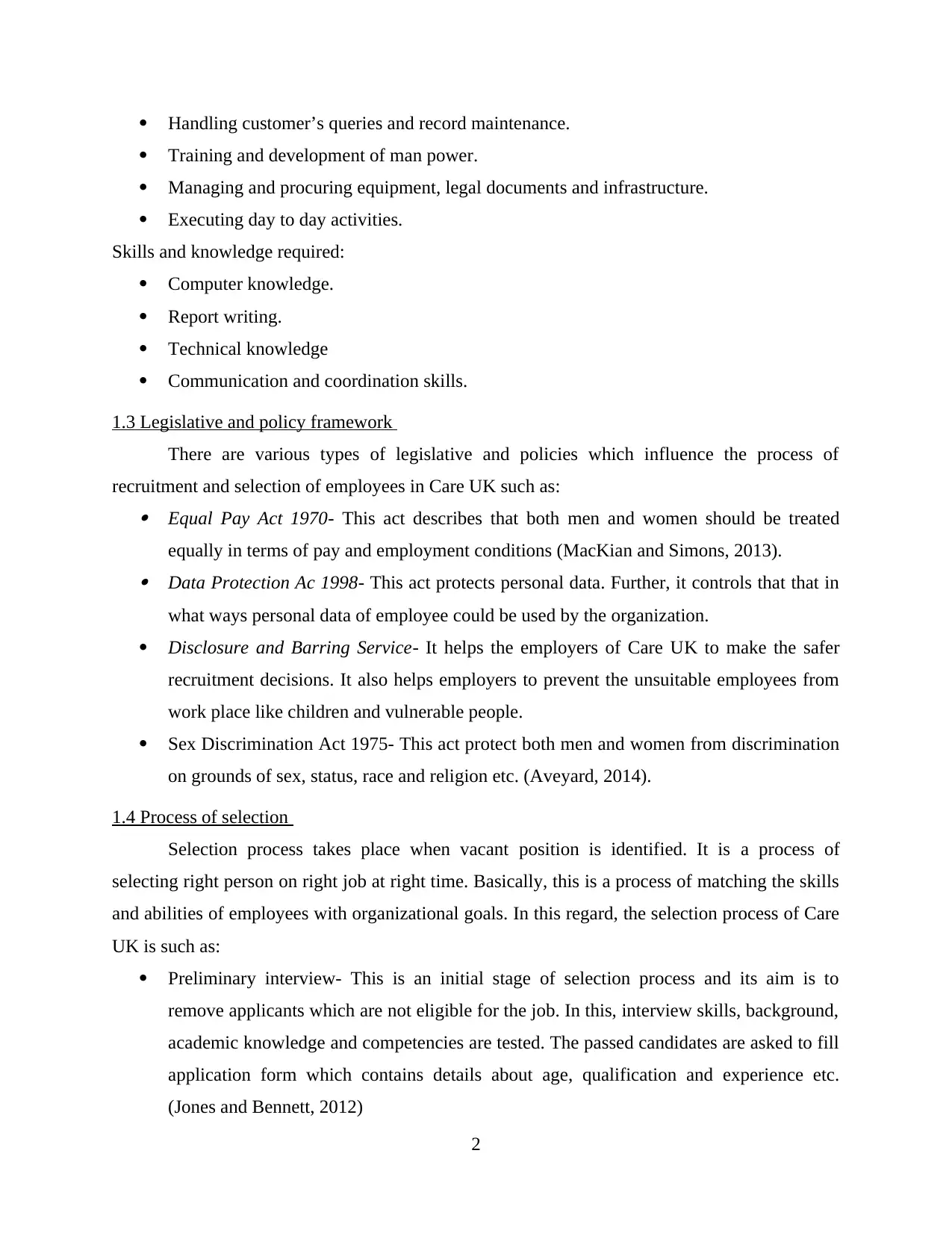
Handling customer’s queries and record maintenance.
Training and development of man power.
Managing and procuring equipment, legal documents and infrastructure.
Executing day to day activities.
Skills and knowledge required:
Computer knowledge.
Report writing.
Technical knowledge
Communication and coordination skills.
1.3 Legislative and policy framework
There are various types of legislative and policies which influence the process of
recruitment and selection of employees in Care UK such as: Equal Pay Act 1970- This act describes that both men and women should be treated
equally in terms of pay and employment conditions (MacKian and Simons, 2013). Data Protection Ac 1998- This act protects personal data. Further, it controls that that in
what ways personal data of employee could be used by the organization.
Disclosure and Barring Service- It helps the employers of Care UK to make the safer
recruitment decisions. It also helps employers to prevent the unsuitable employees from
work place like children and vulnerable people.
Sex Discrimination Act 1975- This act protect both men and women from discrimination
on grounds of sex, status, race and religion etc. (Aveyard, 2014).
1.4 Process of selection
Selection process takes place when vacant position is identified. It is a process of
selecting right person on right job at right time. Basically, this is a process of matching the skills
and abilities of employees with organizational goals. In this regard, the selection process of Care
UK is such as:
Preliminary interview- This is an initial stage of selection process and its aim is to
remove applicants which are not eligible for the job. In this, interview skills, background,
academic knowledge and competencies are tested. The passed candidates are asked to fill
application form which contains details about age, qualification and experience etc.
(Jones and Bennett, 2012)
2
Training and development of man power.
Managing and procuring equipment, legal documents and infrastructure.
Executing day to day activities.
Skills and knowledge required:
Computer knowledge.
Report writing.
Technical knowledge
Communication and coordination skills.
1.3 Legislative and policy framework
There are various types of legislative and policies which influence the process of
recruitment and selection of employees in Care UK such as: Equal Pay Act 1970- This act describes that both men and women should be treated
equally in terms of pay and employment conditions (MacKian and Simons, 2013). Data Protection Ac 1998- This act protects personal data. Further, it controls that that in
what ways personal data of employee could be used by the organization.
Disclosure and Barring Service- It helps the employers of Care UK to make the safer
recruitment decisions. It also helps employers to prevent the unsuitable employees from
work place like children and vulnerable people.
Sex Discrimination Act 1975- This act protect both men and women from discrimination
on grounds of sex, status, race and religion etc. (Aveyard, 2014).
1.4 Process of selection
Selection process takes place when vacant position is identified. It is a process of
selecting right person on right job at right time. Basically, this is a process of matching the skills
and abilities of employees with organizational goals. In this regard, the selection process of Care
UK is such as:
Preliminary interview- This is an initial stage of selection process and its aim is to
remove applicants which are not eligible for the job. In this, interview skills, background,
academic knowledge and competencies are tested. The passed candidates are asked to fill
application form which contains details about age, qualification and experience etc.
(Jones and Bennett, 2012)
2
Paraphrase This Document
Need a fresh take? Get an instant paraphrase of this document with our AI Paraphraser
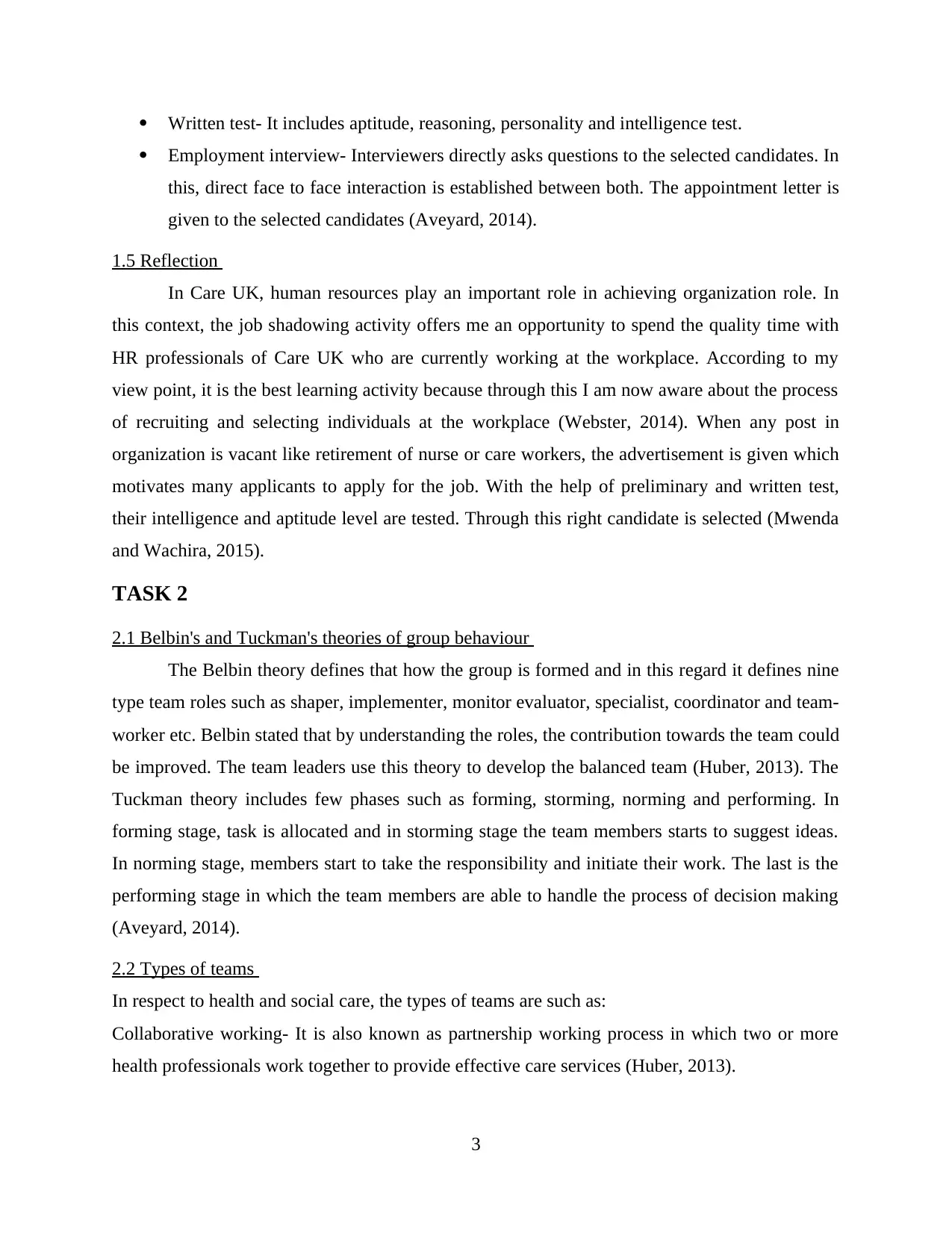
Written test- It includes aptitude, reasoning, personality and intelligence test.
Employment interview- Interviewers directly asks questions to the selected candidates. In
this, direct face to face interaction is established between both. The appointment letter is
given to the selected candidates (Aveyard, 2014).
1.5 Reflection
In Care UK, human resources play an important role in achieving organization role. In
this context, the job shadowing activity offers me an opportunity to spend the quality time with
HR professionals of Care UK who are currently working at the workplace. According to my
view point, it is the best learning activity because through this I am now aware about the process
of recruiting and selecting individuals at the workplace (Webster, 2014). When any post in
organization is vacant like retirement of nurse or care workers, the advertisement is given which
motivates many applicants to apply for the job. With the help of preliminary and written test,
their intelligence and aptitude level are tested. Through this right candidate is selected (Mwenda
and Wachira, 2015).
TASK 2
2.1 Belbin's and Tuckman's theories of group behaviour
The Belbin theory defines that how the group is formed and in this regard it defines nine
type team roles such as shaper, implementer, monitor evaluator, specialist, coordinator and team-
worker etc. Belbin stated that by understanding the roles, the contribution towards the team could
be improved. The team leaders use this theory to develop the balanced team (Huber, 2013). The
Tuckman theory includes few phases such as forming, storming, norming and performing. In
forming stage, task is allocated and in storming stage the team members starts to suggest ideas.
In norming stage, members start to take the responsibility and initiate their work. The last is the
performing stage in which the team members are able to handle the process of decision making
(Aveyard, 2014).
2.2 Types of teams
In respect to health and social care, the types of teams are such as:
Collaborative working- It is also known as partnership working process in which two or more
health professionals work together to provide effective care services (Huber, 2013).
3
Employment interview- Interviewers directly asks questions to the selected candidates. In
this, direct face to face interaction is established between both. The appointment letter is
given to the selected candidates (Aveyard, 2014).
1.5 Reflection
In Care UK, human resources play an important role in achieving organization role. In
this context, the job shadowing activity offers me an opportunity to spend the quality time with
HR professionals of Care UK who are currently working at the workplace. According to my
view point, it is the best learning activity because through this I am now aware about the process
of recruiting and selecting individuals at the workplace (Webster, 2014). When any post in
organization is vacant like retirement of nurse or care workers, the advertisement is given which
motivates many applicants to apply for the job. With the help of preliminary and written test,
their intelligence and aptitude level are tested. Through this right candidate is selected (Mwenda
and Wachira, 2015).
TASK 2
2.1 Belbin's and Tuckman's theories of group behaviour
The Belbin theory defines that how the group is formed and in this regard it defines nine
type team roles such as shaper, implementer, monitor evaluator, specialist, coordinator and team-
worker etc. Belbin stated that by understanding the roles, the contribution towards the team could
be improved. The team leaders use this theory to develop the balanced team (Huber, 2013). The
Tuckman theory includes few phases such as forming, storming, norming and performing. In
forming stage, task is allocated and in storming stage the team members starts to suggest ideas.
In norming stage, members start to take the responsibility and initiate their work. The last is the
performing stage in which the team members are able to handle the process of decision making
(Aveyard, 2014).
2.2 Types of teams
In respect to health and social care, the types of teams are such as:
Collaborative working- It is also known as partnership working process in which two or more
health professionals work together to provide effective care services (Huber, 2013).
3
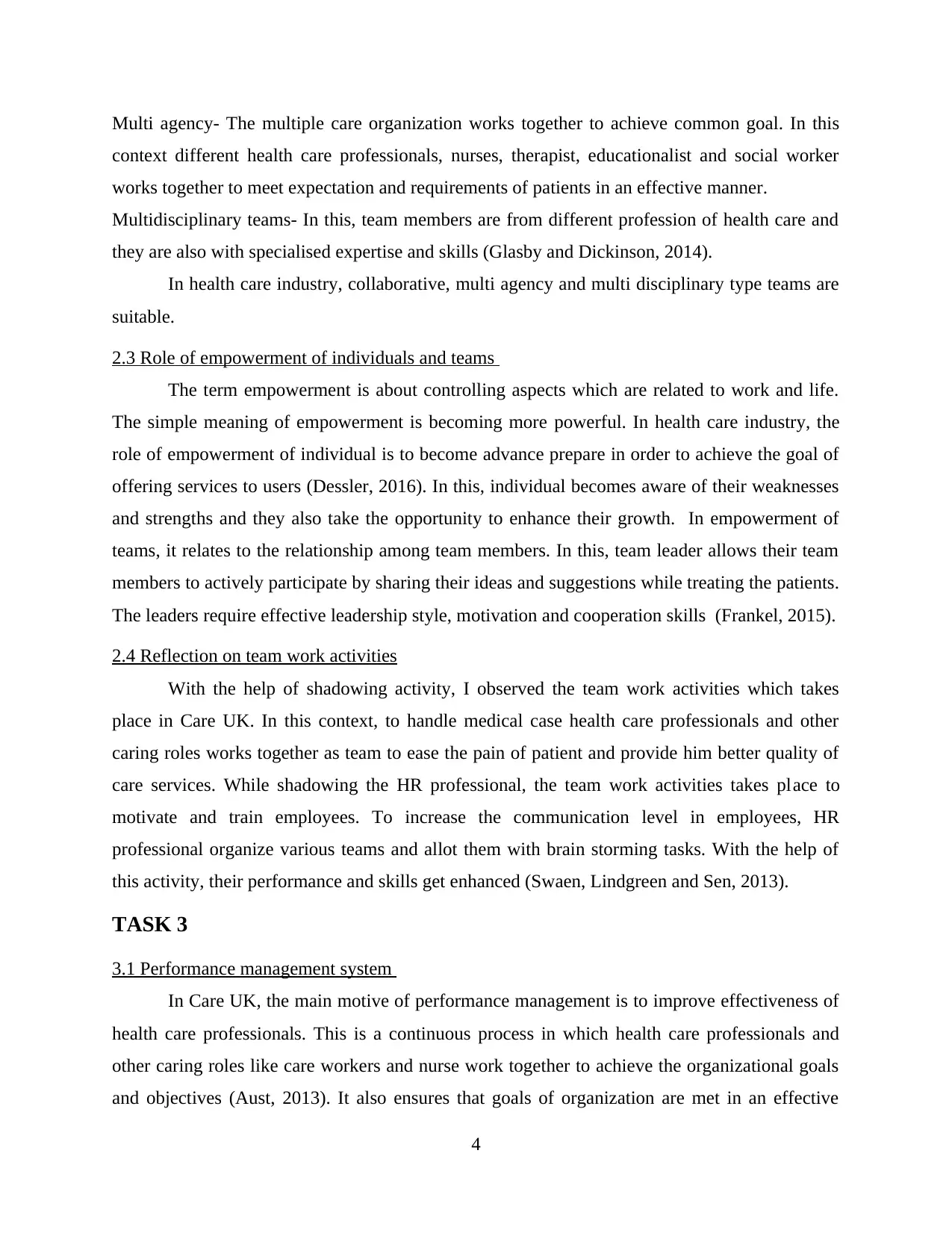
Multi agency- The multiple care organization works together to achieve common goal. In this
context different health care professionals, nurses, therapist, educationalist and social worker
works together to meet expectation and requirements of patients in an effective manner.
Multidisciplinary teams- In this, team members are from different profession of health care and
they are also with specialised expertise and skills (Glasby and Dickinson, 2014).
In health care industry, collaborative, multi agency and multi disciplinary type teams are
suitable.
2.3 Role of empowerment of individuals and teams
The term empowerment is about controlling aspects which are related to work and life.
The simple meaning of empowerment is becoming more powerful. In health care industry, the
role of empowerment of individual is to become advance prepare in order to achieve the goal of
offering services to users (Dessler, 2016). In this, individual becomes aware of their weaknesses
and strengths and they also take the opportunity to enhance their growth. In empowerment of
teams, it relates to the relationship among team members. In this, team leader allows their team
members to actively participate by sharing their ideas and suggestions while treating the patients.
The leaders require effective leadership style, motivation and cooperation skills (Frankel, 2015).
2.4 Reflection on team work activities
With the help of shadowing activity, I observed the team work activities which takes
place in Care UK. In this context, to handle medical case health care professionals and other
caring roles works together as team to ease the pain of patient and provide him better quality of
care services. While shadowing the HR professional, the team work activities takes place to
motivate and train employees. To increase the communication level in employees, HR
professional organize various teams and allot them with brain storming tasks. With the help of
this activity, their performance and skills get enhanced (Swaen, Lindgreen and Sen, 2013).
TASK 3
3.1 Performance management system
In Care UK, the main motive of performance management is to improve effectiveness of
health care professionals. This is a continuous process in which health care professionals and
other caring roles like care workers and nurse work together to achieve the organizational goals
and objectives (Aust, 2013). It also ensures that goals of organization are met in an effective
4
context different health care professionals, nurses, therapist, educationalist and social worker
works together to meet expectation and requirements of patients in an effective manner.
Multidisciplinary teams- In this, team members are from different profession of health care and
they are also with specialised expertise and skills (Glasby and Dickinson, 2014).
In health care industry, collaborative, multi agency and multi disciplinary type teams are
suitable.
2.3 Role of empowerment of individuals and teams
The term empowerment is about controlling aspects which are related to work and life.
The simple meaning of empowerment is becoming more powerful. In health care industry, the
role of empowerment of individual is to become advance prepare in order to achieve the goal of
offering services to users (Dessler, 2016). In this, individual becomes aware of their weaknesses
and strengths and they also take the opportunity to enhance their growth. In empowerment of
teams, it relates to the relationship among team members. In this, team leader allows their team
members to actively participate by sharing their ideas and suggestions while treating the patients.
The leaders require effective leadership style, motivation and cooperation skills (Frankel, 2015).
2.4 Reflection on team work activities
With the help of shadowing activity, I observed the team work activities which takes
place in Care UK. In this context, to handle medical case health care professionals and other
caring roles works together as team to ease the pain of patient and provide him better quality of
care services. While shadowing the HR professional, the team work activities takes place to
motivate and train employees. To increase the communication level in employees, HR
professional organize various teams and allot them with brain storming tasks. With the help of
this activity, their performance and skills get enhanced (Swaen, Lindgreen and Sen, 2013).
TASK 3
3.1 Performance management system
In Care UK, the main motive of performance management is to improve effectiveness of
health care professionals. This is a continuous process in which health care professionals and
other caring roles like care workers and nurse work together to achieve the organizational goals
and objectives (Aust, 2013). It also ensures that goals of organization are met in an effective
4
⊘ This is a preview!⊘
Do you want full access?
Subscribe today to unlock all pages.

Trusted by 1+ million students worldwide
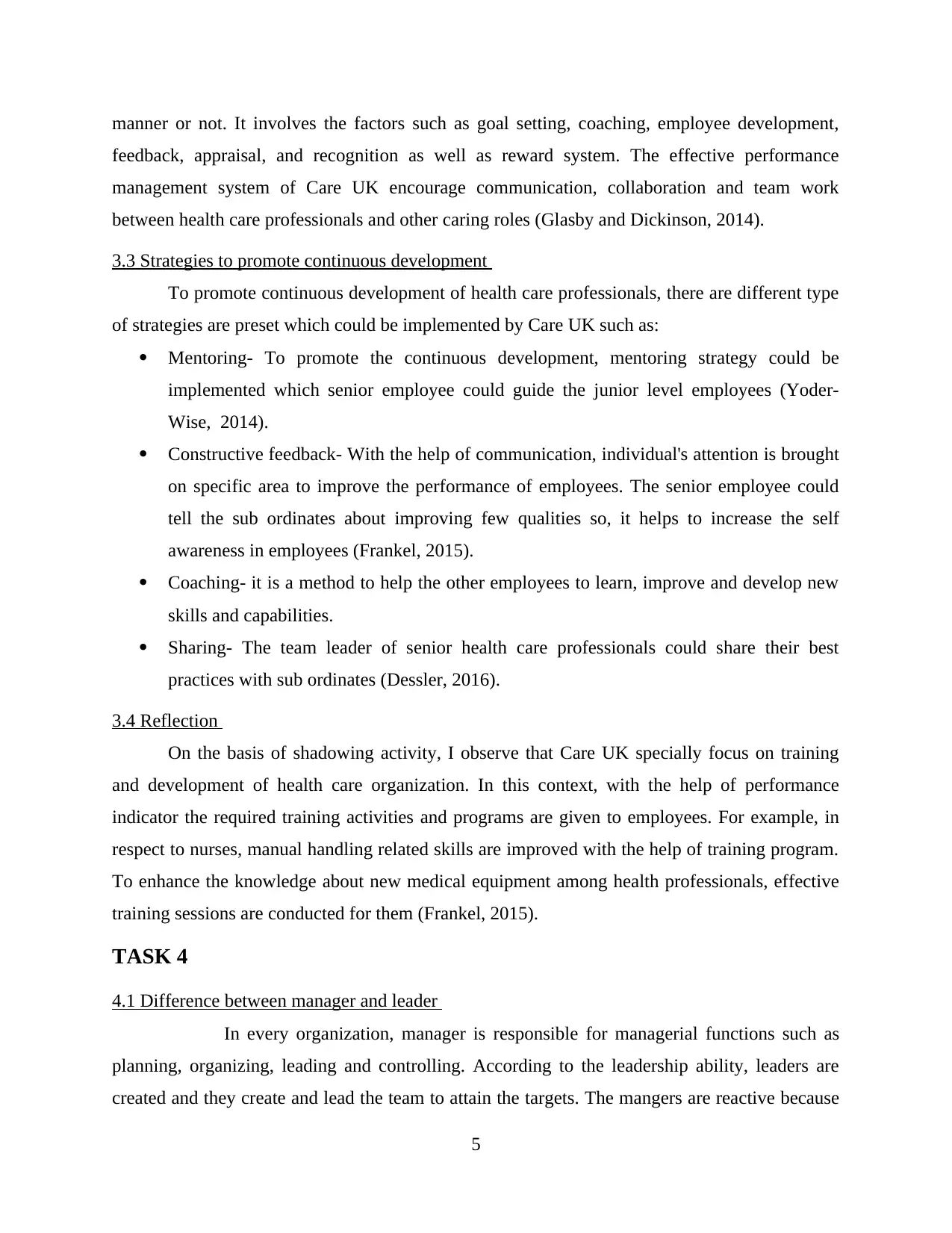
manner or not. It involves the factors such as goal setting, coaching, employee development,
feedback, appraisal, and recognition as well as reward system. The effective performance
management system of Care UK encourage communication, collaboration and team work
between health care professionals and other caring roles (Glasby and Dickinson, 2014).
3.3 Strategies to promote continuous development
To promote continuous development of health care professionals, there are different type
of strategies are preset which could be implemented by Care UK such as:
Mentoring- To promote the continuous development, mentoring strategy could be
implemented which senior employee could guide the junior level employees (Yoder-
Wise, 2014).
Constructive feedback- With the help of communication, individual's attention is brought
on specific area to improve the performance of employees. The senior employee could
tell the sub ordinates about improving few qualities so, it helps to increase the self
awareness in employees (Frankel, 2015).
Coaching- it is a method to help the other employees to learn, improve and develop new
skills and capabilities.
Sharing- The team leader of senior health care professionals could share their best
practices with sub ordinates (Dessler, 2016).
3.4 Reflection
On the basis of shadowing activity, I observe that Care UK specially focus on training
and development of health care organization. In this context, with the help of performance
indicator the required training activities and programs are given to employees. For example, in
respect to nurses, manual handling related skills are improved with the help of training program.
To enhance the knowledge about new medical equipment among health professionals, effective
training sessions are conducted for them (Frankel, 2015).
TASK 4
4.1 Difference between manager and leader
In every organization, manager is responsible for managerial functions such as
planning, organizing, leading and controlling. According to the leadership ability, leaders are
created and they create and lead the team to attain the targets. The mangers are reactive because
5
feedback, appraisal, and recognition as well as reward system. The effective performance
management system of Care UK encourage communication, collaboration and team work
between health care professionals and other caring roles (Glasby and Dickinson, 2014).
3.3 Strategies to promote continuous development
To promote continuous development of health care professionals, there are different type
of strategies are preset which could be implemented by Care UK such as:
Mentoring- To promote the continuous development, mentoring strategy could be
implemented which senior employee could guide the junior level employees (Yoder-
Wise, 2014).
Constructive feedback- With the help of communication, individual's attention is brought
on specific area to improve the performance of employees. The senior employee could
tell the sub ordinates about improving few qualities so, it helps to increase the self
awareness in employees (Frankel, 2015).
Coaching- it is a method to help the other employees to learn, improve and develop new
skills and capabilities.
Sharing- The team leader of senior health care professionals could share their best
practices with sub ordinates (Dessler, 2016).
3.4 Reflection
On the basis of shadowing activity, I observe that Care UK specially focus on training
and development of health care organization. In this context, with the help of performance
indicator the required training activities and programs are given to employees. For example, in
respect to nurses, manual handling related skills are improved with the help of training program.
To enhance the knowledge about new medical equipment among health professionals, effective
training sessions are conducted for them (Frankel, 2015).
TASK 4
4.1 Difference between manager and leader
In every organization, manager is responsible for managerial functions such as
planning, organizing, leading and controlling. According to the leadership ability, leaders are
created and they create and lead the team to attain the targets. The mangers are reactive because
5
Paraphrase This Document
Need a fresh take? Get an instant paraphrase of this document with our AI Paraphraser
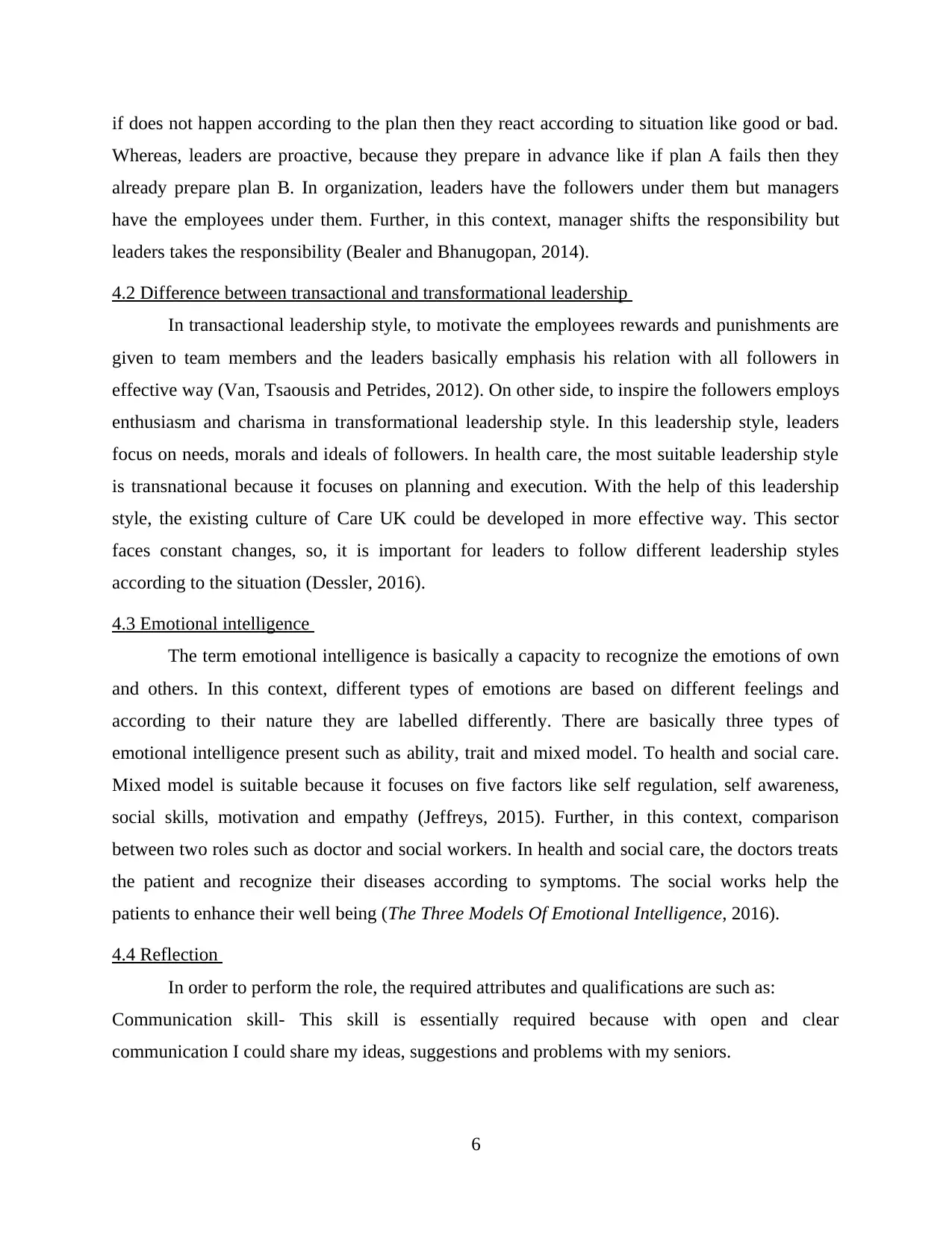
if does not happen according to the plan then they react according to situation like good or bad.
Whereas, leaders are proactive, because they prepare in advance like if plan A fails then they
already prepare plan B. In organization, leaders have the followers under them but managers
have the employees under them. Further, in this context, manager shifts the responsibility but
leaders takes the responsibility (Bealer and Bhanugopan, 2014).
4.2 Difference between transactional and transformational leadership
In transactional leadership style, to motivate the employees rewards and punishments are
given to team members and the leaders basically emphasis his relation with all followers in
effective way (Van, Tsaousis and Petrides, 2012). On other side, to inspire the followers employs
enthusiasm and charisma in transformational leadership style. In this leadership style, leaders
focus on needs, morals and ideals of followers. In health care, the most suitable leadership style
is transnational because it focuses on planning and execution. With the help of this leadership
style, the existing culture of Care UK could be developed in more effective way. This sector
faces constant changes, so, it is important for leaders to follow different leadership styles
according to the situation (Dessler, 2016).
4.3 Emotional intelligence
The term emotional intelligence is basically a capacity to recognize the emotions of own
and others. In this context, different types of emotions are based on different feelings and
according to their nature they are labelled differently. There are basically three types of
emotional intelligence present such as ability, trait and mixed model. To health and social care.
Mixed model is suitable because it focuses on five factors like self regulation, self awareness,
social skills, motivation and empathy (Jeffreys, 2015). Further, in this context, comparison
between two roles such as doctor and social workers. In health and social care, the doctors treats
the patient and recognize their diseases according to symptoms. The social works help the
patients to enhance their well being (The Three Models Of Emotional Intelligence, 2016).
4.4 Reflection
In order to perform the role, the required attributes and qualifications are such as:
Communication skill- This skill is essentially required because with open and clear
communication I could share my ideas, suggestions and problems with my seniors.
6
Whereas, leaders are proactive, because they prepare in advance like if plan A fails then they
already prepare plan B. In organization, leaders have the followers under them but managers
have the employees under them. Further, in this context, manager shifts the responsibility but
leaders takes the responsibility (Bealer and Bhanugopan, 2014).
4.2 Difference between transactional and transformational leadership
In transactional leadership style, to motivate the employees rewards and punishments are
given to team members and the leaders basically emphasis his relation with all followers in
effective way (Van, Tsaousis and Petrides, 2012). On other side, to inspire the followers employs
enthusiasm and charisma in transformational leadership style. In this leadership style, leaders
focus on needs, morals and ideals of followers. In health care, the most suitable leadership style
is transnational because it focuses on planning and execution. With the help of this leadership
style, the existing culture of Care UK could be developed in more effective way. This sector
faces constant changes, so, it is important for leaders to follow different leadership styles
according to the situation (Dessler, 2016).
4.3 Emotional intelligence
The term emotional intelligence is basically a capacity to recognize the emotions of own
and others. In this context, different types of emotions are based on different feelings and
according to their nature they are labelled differently. There are basically three types of
emotional intelligence present such as ability, trait and mixed model. To health and social care.
Mixed model is suitable because it focuses on five factors like self regulation, self awareness,
social skills, motivation and empathy (Jeffreys, 2015). Further, in this context, comparison
between two roles such as doctor and social workers. In health and social care, the doctors treats
the patient and recognize their diseases according to symptoms. The social works help the
patients to enhance their well being (The Three Models Of Emotional Intelligence, 2016).
4.4 Reflection
In order to perform the role, the required attributes and qualifications are such as:
Communication skill- This skill is essentially required because with open and clear
communication I could share my ideas, suggestions and problems with my seniors.
6
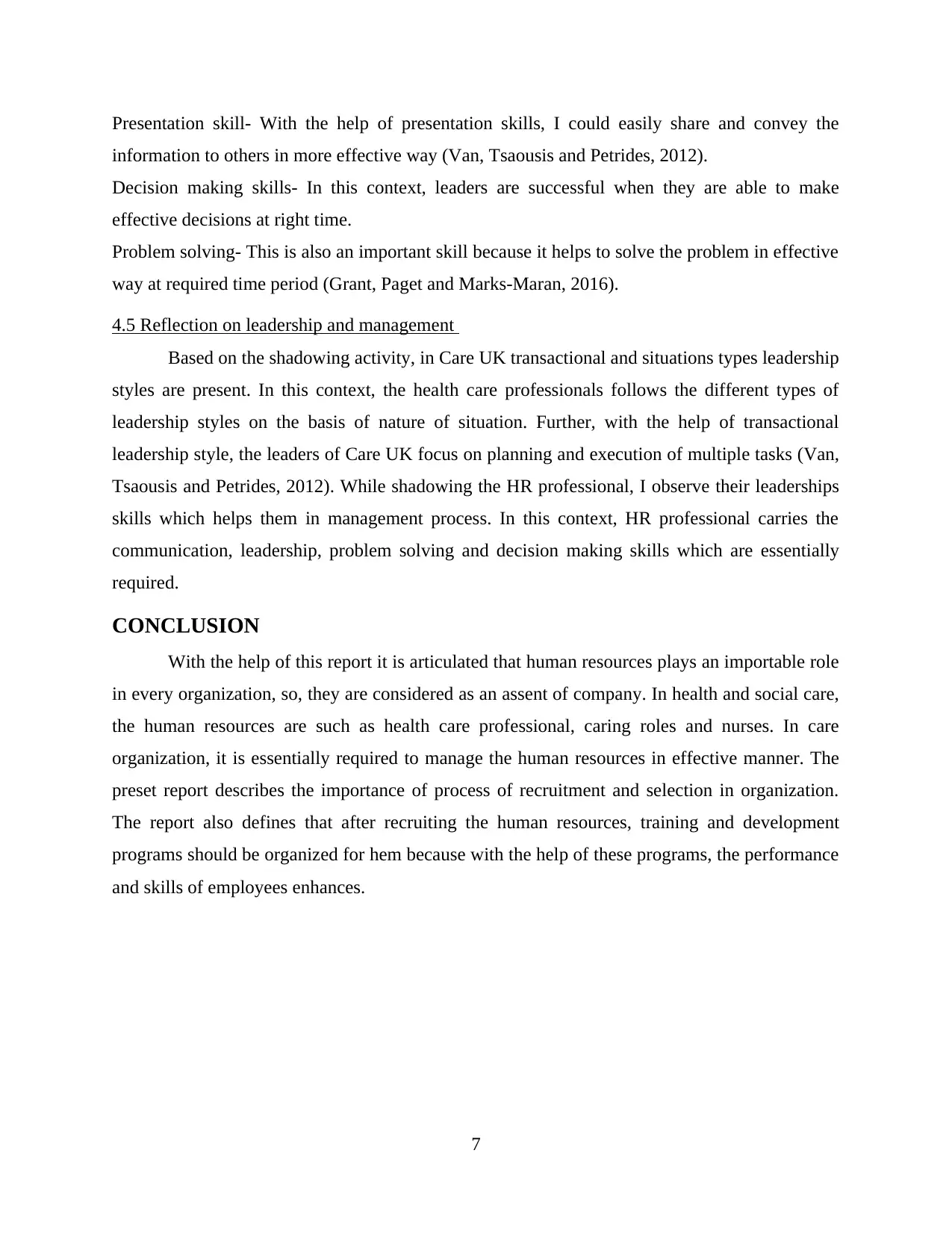
Presentation skill- With the help of presentation skills, I could easily share and convey the
information to others in more effective way (Van, Tsaousis and Petrides, 2012).
Decision making skills- In this context, leaders are successful when they are able to make
effective decisions at right time.
Problem solving- This is also an important skill because it helps to solve the problem in effective
way at required time period (Grant, Paget and Marks-Maran, 2016).
4.5 Reflection on leadership and management
Based on the shadowing activity, in Care UK transactional and situations types leadership
styles are present. In this context, the health care professionals follows the different types of
leadership styles on the basis of nature of situation. Further, with the help of transactional
leadership style, the leaders of Care UK focus on planning and execution of multiple tasks (Van,
Tsaousis and Petrides, 2012). While shadowing the HR professional, I observe their leaderships
skills which helps them in management process. In this context, HR professional carries the
communication, leadership, problem solving and decision making skills which are essentially
required.
CONCLUSION
With the help of this report it is articulated that human resources plays an importable role
in every organization, so, they are considered as an assent of company. In health and social care,
the human resources are such as health care professional, caring roles and nurses. In care
organization, it is essentially required to manage the human resources in effective manner. The
preset report describes the importance of process of recruitment and selection in organization.
The report also defines that after recruiting the human resources, training and development
programs should be organized for hem because with the help of these programs, the performance
and skills of employees enhances.
7
information to others in more effective way (Van, Tsaousis and Petrides, 2012).
Decision making skills- In this context, leaders are successful when they are able to make
effective decisions at right time.
Problem solving- This is also an important skill because it helps to solve the problem in effective
way at required time period (Grant, Paget and Marks-Maran, 2016).
4.5 Reflection on leadership and management
Based on the shadowing activity, in Care UK transactional and situations types leadership
styles are present. In this context, the health care professionals follows the different types of
leadership styles on the basis of nature of situation. Further, with the help of transactional
leadership style, the leaders of Care UK focus on planning and execution of multiple tasks (Van,
Tsaousis and Petrides, 2012). While shadowing the HR professional, I observe their leaderships
skills which helps them in management process. In this context, HR professional carries the
communication, leadership, problem solving and decision making skills which are essentially
required.
CONCLUSION
With the help of this report it is articulated that human resources plays an importable role
in every organization, so, they are considered as an assent of company. In health and social care,
the human resources are such as health care professional, caring roles and nurses. In care
organization, it is essentially required to manage the human resources in effective manner. The
preset report describes the importance of process of recruitment and selection in organization.
The report also defines that after recruiting the human resources, training and development
programs should be organized for hem because with the help of these programs, the performance
and skills of employees enhances.
7
⊘ This is a preview!⊘
Do you want full access?
Subscribe today to unlock all pages.

Trusted by 1+ million students worldwide
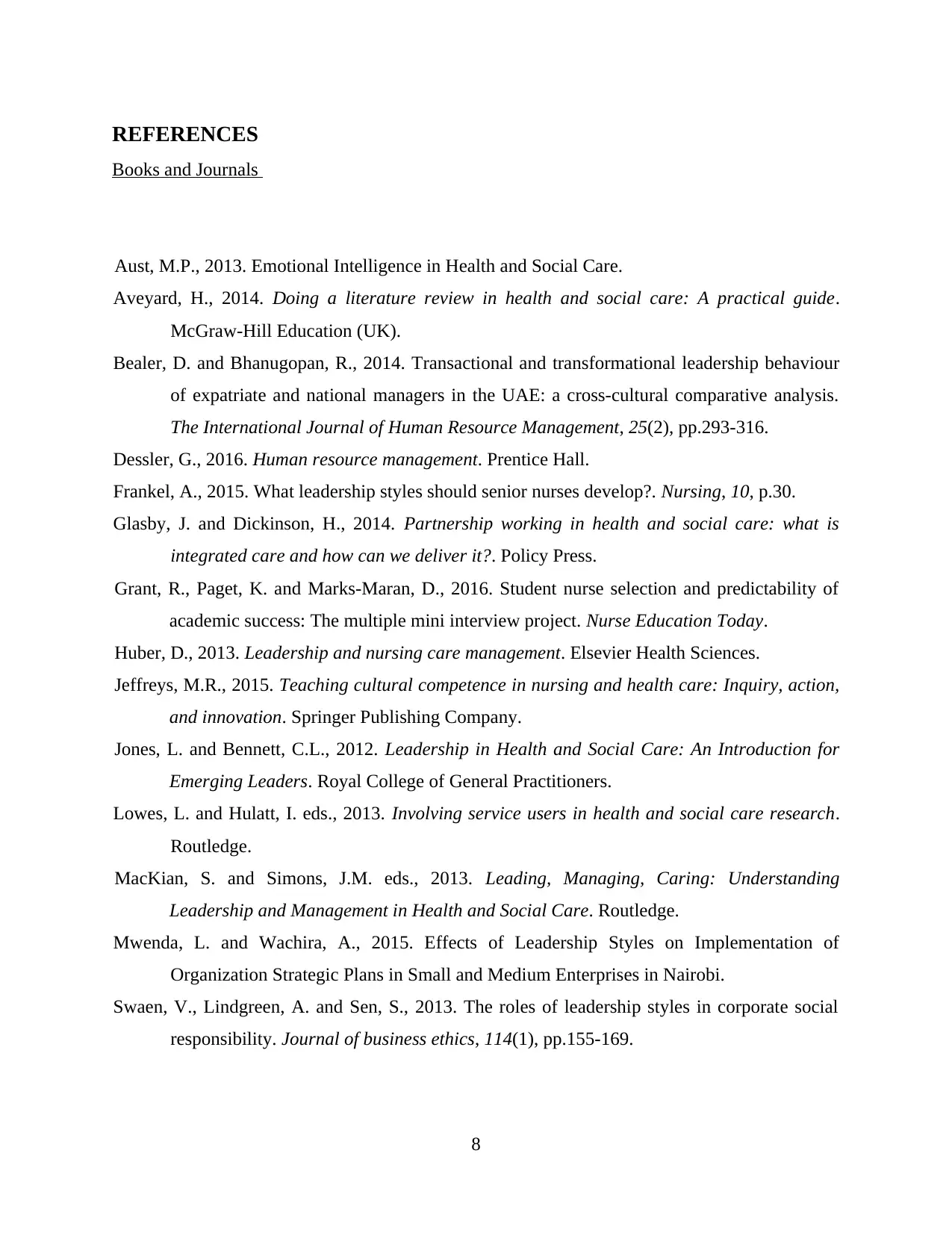
REFERENCES
Books and Journals
Aust, M.P., 2013. Emotional Intelligence in Health and Social Care.
Aveyard, H., 2014. Doing a literature review in health and social care: A practical guide.
McGraw-Hill Education (UK).
Bealer, D. and Bhanugopan, R., 2014. Transactional and transformational leadership behaviour
of expatriate and national managers in the UAE: a cross-cultural comparative analysis.
The International Journal of Human Resource Management, 25(2), pp.293-316.
Dessler, G., 2016. Human resource management. Prentice Hall.
Frankel, A., 2015. What leadership styles should senior nurses develop?. Nursing, 10, p.30.
Glasby, J. and Dickinson, H., 2014. Partnership working in health and social care: what is
integrated care and how can we deliver it?. Policy Press.
Grant, R., Paget, K. and Marks-Maran, D., 2016. Student nurse selection and predictability of
academic success: The multiple mini interview project. Nurse Education Today.
Huber, D., 2013. Leadership and nursing care management. Elsevier Health Sciences.
Jeffreys, M.R., 2015. Teaching cultural competence in nursing and health care: Inquiry, action,
and innovation. Springer Publishing Company.
Jones, L. and Bennett, C.L., 2012. Leadership in Health and Social Care: An Introduction for
Emerging Leaders. Royal College of General Practitioners.
Lowes, L. and Hulatt, I. eds., 2013. Involving service users in health and social care research.
Routledge.
MacKian, S. and Simons, J.M. eds., 2013. Leading, Managing, Caring: Understanding
Leadership and Management in Health and Social Care. Routledge.
Mwenda, L. and Wachira, A., 2015. Effects of Leadership Styles on Implementation of
Organization Strategic Plans in Small and Medium Enterprises in Nairobi.
Swaen, V., Lindgreen, A. and Sen, S., 2013. The roles of leadership styles in corporate social
responsibility. Journal of business ethics, 114(1), pp.155-169.
8
Books and Journals
Aust, M.P., 2013. Emotional Intelligence in Health and Social Care.
Aveyard, H., 2014. Doing a literature review in health and social care: A practical guide.
McGraw-Hill Education (UK).
Bealer, D. and Bhanugopan, R., 2014. Transactional and transformational leadership behaviour
of expatriate and national managers in the UAE: a cross-cultural comparative analysis.
The International Journal of Human Resource Management, 25(2), pp.293-316.
Dessler, G., 2016. Human resource management. Prentice Hall.
Frankel, A., 2015. What leadership styles should senior nurses develop?. Nursing, 10, p.30.
Glasby, J. and Dickinson, H., 2014. Partnership working in health and social care: what is
integrated care and how can we deliver it?. Policy Press.
Grant, R., Paget, K. and Marks-Maran, D., 2016. Student nurse selection and predictability of
academic success: The multiple mini interview project. Nurse Education Today.
Huber, D., 2013. Leadership and nursing care management. Elsevier Health Sciences.
Jeffreys, M.R., 2015. Teaching cultural competence in nursing and health care: Inquiry, action,
and innovation. Springer Publishing Company.
Jones, L. and Bennett, C.L., 2012. Leadership in Health and Social Care: An Introduction for
Emerging Leaders. Royal College of General Practitioners.
Lowes, L. and Hulatt, I. eds., 2013. Involving service users in health and social care research.
Routledge.
MacKian, S. and Simons, J.M. eds., 2013. Leading, Managing, Caring: Understanding
Leadership and Management in Health and Social Care. Routledge.
Mwenda, L. and Wachira, A., 2015. Effects of Leadership Styles on Implementation of
Organization Strategic Plans in Small and Medium Enterprises in Nairobi.
Swaen, V., Lindgreen, A. and Sen, S., 2013. The roles of leadership styles in corporate social
responsibility. Journal of business ethics, 114(1), pp.155-169.
8
Paraphrase This Document
Need a fresh take? Get an instant paraphrase of this document with our AI Paraphraser
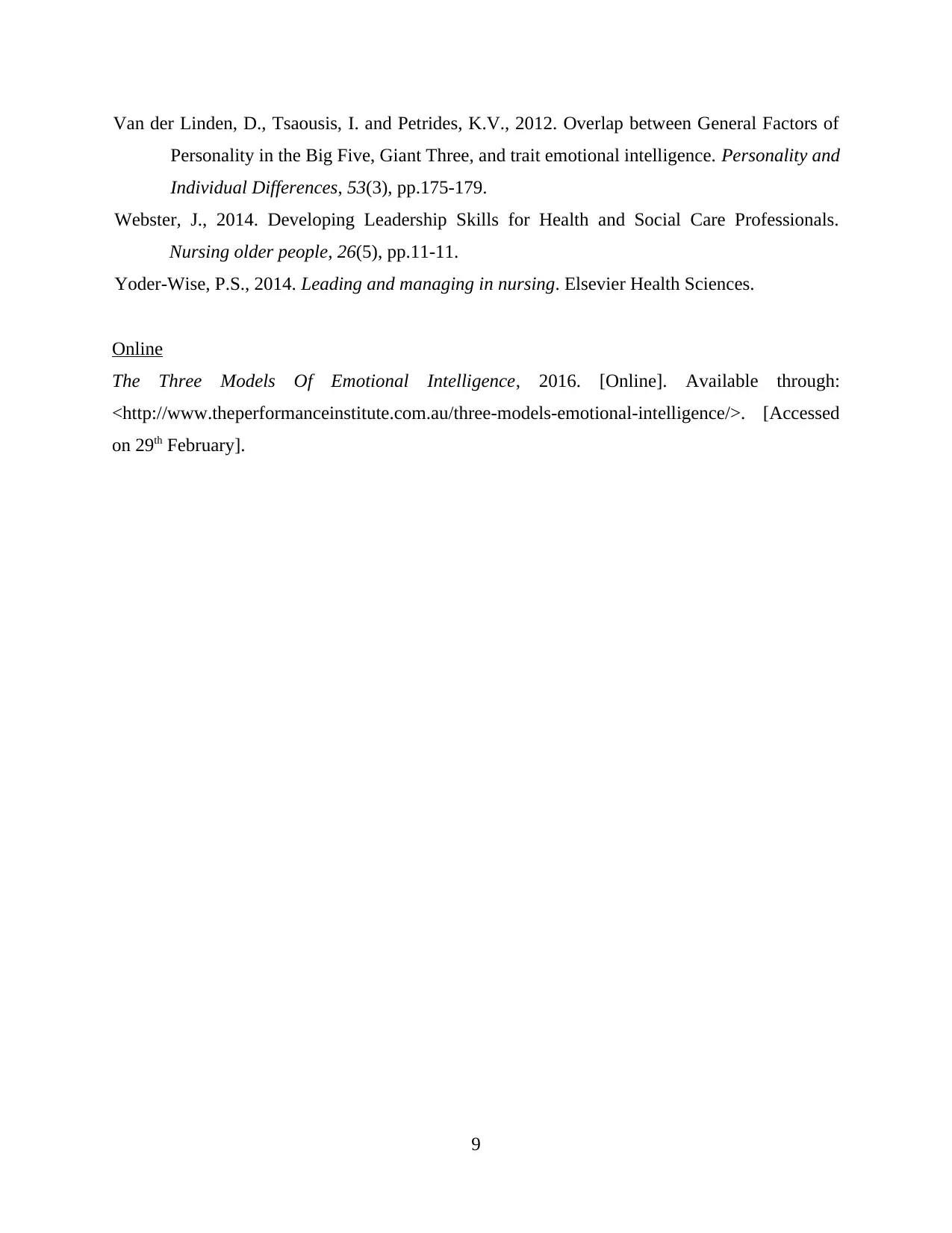
Van der Linden, D., Tsaousis, I. and Petrides, K.V., 2012. Overlap between General Factors of
Personality in the Big Five, Giant Three, and trait emotional intelligence. Personality and
Individual Differences, 53(3), pp.175-179.
Webster, J., 2014. Developing Leadership Skills for Health and Social Care Professionals.
Nursing older people, 26(5), pp.11-11.
Yoder-Wise, P.S., 2014. Leading and managing in nursing. Elsevier Health Sciences.
Online
The Three Models Of Emotional Intelligence, 2016. [Online]. Available through:
<http://www.theperformanceinstitute.com.au/three-models-emotional-intelligence/>. [Accessed
on 29th February].
9
Personality in the Big Five, Giant Three, and trait emotional intelligence. Personality and
Individual Differences, 53(3), pp.175-179.
Webster, J., 2014. Developing Leadership Skills for Health and Social Care Professionals.
Nursing older people, 26(5), pp.11-11.
Yoder-Wise, P.S., 2014. Leading and managing in nursing. Elsevier Health Sciences.
Online
The Three Models Of Emotional Intelligence, 2016. [Online]. Available through:
<http://www.theperformanceinstitute.com.au/three-models-emotional-intelligence/>. [Accessed
on 29th February].
9
1 out of 11
Related Documents
Your All-in-One AI-Powered Toolkit for Academic Success.
+13062052269
info@desklib.com
Available 24*7 on WhatsApp / Email
![[object Object]](/_next/static/media/star-bottom.7253800d.svg)
Unlock your academic potential
Copyright © 2020–2025 A2Z Services. All Rights Reserved. Developed and managed by ZUCOL.





